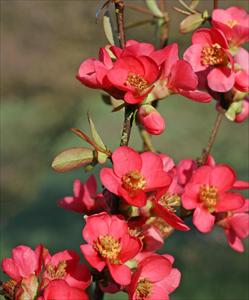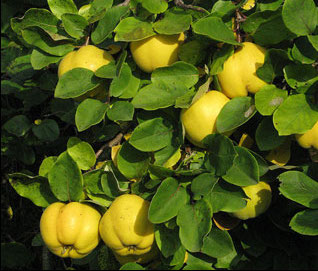From Quince It Comes
By Carolyn R. Casey, Fairfax Master Gardener

Flowering Quince
Flowering Quince and Common Quince make delicious edible additions to your garden that attract hummingbirds and butterflies. They not only provide you with beautiful, showy spring flowers but also fruit that can be used to make preserves and jellies.
Flowering Quince (Chaenomeles speciosa) is a tough and hardy shrub that has thorns. It is a deciduous broadleaf upright shrub in the Rosacea family and native to China. It is a fast and easy-to-grow shrub in areas with well-drained soil and medium moisture. Mature plants are mildly drought tolerant. It tolerates lots of soil conditions, except alkaline soils, and likes acidic, sandy, loam or clay soil with a pH of 3.7 to 7.0. Chlorosis occurs in soils with a high pH. It also tolerates extreme hot and cold temperatures and will grow in Zones 4 to 9.
Flowering Quince blooms in March and April with a showy abundance of gold yellow, green or red burgundy flowers that have four to five petals and bloom for 10 to 14 days. It produces more blooms when planted in the sun but will tolerate shade. The flowers can be either single or double blooms that are 1.5 inches (4 cm) in diameter and appear before the foliage. Early spring frosts may damage the flower buds. The foliage is also gold yellow, green or red burgundy in color.
It produces hard and bitter fruit that is inedible right off the shrub. The fruit is called a pome and appears in the fall and can be used to make preserves, jellies or can be eaten after it has been left out to ripen. The fruit is fragrant with a yellow-green color that turns yellow in the fall and is about 2.5 inches long (6 cm). Flowering Quince blooms on old growth, and if you want the fruit it is recommended that you moderately prune it. When heavily pruned in the spring, it stimulates growth of flowering spurs for the next year. This pruning will reduce fruit production for the current year but increase the next year’s flowering.
It is a dense, broad, erect, multi-stemmed thorny and spreading shrub. It is easy to transplant and grows 6 to 10 feet tall and 6 to 10 feet wide (2-3 m). To keep the plant’s size and shape, prune it after it blooms each spring. Prune to remove diseased and broken branches, and also remove the suckers if you don’t want it to spread. Remove no more than 1/3 of the plant when you prune, including old and weak branches. Prune these branches to the ground.
It may be eaten by deer and rabbits and attracts birds, hummingbirds and butterflies. It is susceptible to fungal leaf spot, fire blight and scab. Aphids may damage new growth; also scale and mites may be a problem. It can be planted in containers or on slopes and banks. Flowering Quince can also be used as a specimen plant and can be trained to grow on a trellis.
Flowering Quince Cultivars

Toyo-Nishiki quince
‘Toyo-Nishiki’ (Chaenomeles speciosa) is known as Flowering Quince or Japanese Quince. This suckering shrub has a rounded and spreading shape that grows 5 to 10 feet (1.5 – 3 m) high and wide. It blooms with a unique combination of red, white and pink flowers, and all three colors may appear on the same flower. It grows in Zones 5 to 9.
‘Double Take’ Flowering Quince shrubs are now classified as Chaenomeles lagenaria and formerly were Chaenomeles speciosa. These varieties are thornless and fruitless with double flowers that resemble Camellias. They bloom from February to April in Zones 5 to 9. They grow 4 to 5 feet (1.2-1.5 m) tall and 4 to 6 feet (1.4-2 m) wide and frequently rebloom in the fall. ‘Scarlet Storm,’ ‘Pink Storm’ and ‘Orange Storm’ are members of the ‘Double Take’ Flowering Quince family. ‘Scarlet Storm’ has big velvety, dark red flowers with a 2.5 inch diameter and 17 to 25 petals per flower. ‘Pink Storm’ has large double salmon or coral flowers that are 2 inches in diameter that look like sweetheart roses. ‘Orange Storm’ has large bright orange double blooms with 31 to 49 petals per flower.
In 1822, John Lindley created the genus Chaenomeles to distinguish the Flowering Quince, which has stamens in two rows, from Common Quince (Cydonia) with stamens in one row and a different fruit anatomy. An easier way to distinguish these genera is that Chaenomeles is usually planted as an ornamental shrub with showy flowers, whereas Common Quince (Cydonia oblonga) is grown for its fruit.
Common Quince
Common Quince is a deciduous grafted tree in the Rosaceae family. It originates from Asia Minor and is usually self-pollinated. However, some believe the flowers may need cross pollination to produce good fruit. It has branches that are twisted and crowded and have an irregular shape. It has beautiful white or pink flowers that bloom in the spring. The foliage is a deep green that has a smooth upper surface and hairy lower surface.
They have been used as dwarfing rootstock for European pear trees. Comice pear trees grafted with Quince rootstock bear fruit at a younger age and produce regular crops with good-sized quality fruit. When Quince rootstock is grafted with Bartlett or Bostic pear, there is poor compatibility.
At first, the Common Quince fruit is covered with dense grayish white hairs that disappear as the fruit ripens. The fruit is a golden yellow color when it ripens and looks like a pear or apple. A thin skin protects the soft yellow and grainy pulp. The fruit is yellow and aromatic, about 3.5 to 4.5 inches long (9-11 cm)and will attract deer. The fruit needs to be cut from the tree with a sharp knife and harvested when mature but not ripe. The fruit is bitter and acidic, but when cooked develops a sweet taste specially when poached. It is used to impart rare aromas, desired bitter flavor and astringency to fermented or hard cider. It is high in pectin after it turns a golden yellow color and is used in jelly, tarts and pies.

Common quince fruit
Common Quince can grow from 16 to 26 feet tall and lives for more than 50 years. It likes full sun and grows in a wide variety of climates and soils. A shallow root system makes it susceptible to drought, so it needs to be watered regularly. It tolerates wet soils and drought better than other fruit trees and benefits from deep watering during the summer months. Plant it in a sheltered area since it can be damaged by strong winds. It is hardy in cold weather in Zones 5 to 9.
Problems with Common Quince include fire blight, brown rot and leaf blight. Fertilizing with lots of nitrogen makes it susceptible to bacterium. Many of these trees have the same pest problems as apple and pear trees. Prune out suckers in the winter or early spring and prune the trees in the winter to remove fruiting wood and encourage new growth.
Common Quince Cultivars
The Common Quince cultivar ‘Jumbo’ has white-fleshed fruit, whereas ‘Orange’ has more round, orange-yellow flesh. ‘Pineapple’ has white flesh with a pineapple flavor, and ‘Smyrna’ has pink flowers and fruit with a waxy and yellow skin.
Quince makes a beautiful, edible addition to your garden. Happy gardening!
Resources
• Quince, Plant Village, Pennsylvania State University
• Flowering Quince and Cultivars, North Carolina Cooperative Extension Gardener Plant Toolbox
• Common Quince, Cydonia versus Flowering Quince, Chaenomeles, Division of Plant Sciences,
University of Missouri Integrated Pest Management
• Flowering Quince (Chaenomeles speciosa), Alex X. Niemiera, Virginia Cooperative Extension